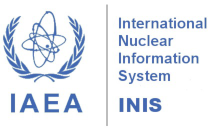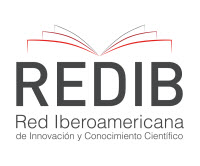Radiation Dose Coefficients for Healthcare Waste and Water Comparison
DOI:
https://doi.org/10.15392/2319-0612.2025.2797Keywords:
KERMA-fluence coefficient, Mass Stopping Power, Composition of Hospital Healthcare Waste, Pathogenic Radiation Inactivation, Industrial IrradiationAbstract
According to national and international standards, some groups and subgroups of Healthcare Services Waste (RSS) must undergo some type of treatment to reduce or eliminate the pathogen load before final disposal, to avoid harm to human health and the environment. The pathogens present in the infecting HCW can be effectively inactivated by radiation, providing a uniform minimum dose recommended over the entire volume of the HCW. The analysis of radiation transport in HCW containment containers require determination of the radiation dose coefficients, called: KERMA-fluence for photons and the Mass Stopping Power for electrons; to verify whether the absorbed dose in the container was sufficient for pathogenic inactivation. The chemical compositions of segregated HCW, as well as non-segregated HCW, were evaluated by previous analytical studies by means of segregation of hospital waste. The mass energy absorption coefficients for the chemical composition of HCW at various energies of photon beams and the related density of the RSS supported the calculations of the Radiation Dose Coefficients, KERMA-fluence, and the Mass Stopping Power of electrons for HCW. The results for HCW were compared with equivalent water parameters. The water material does not represent a good substitute for HCW in the dosimetric processes of calibration of exposures to X-ray radiation and electrons in most of the energy spectrum analyzed. There are significant differences between the KERMA-fluence and Mass Stopping Power coefficients of the HCW in relation to water, inducing a very different energy fluency in the RSS in relation to water. A better radiological characterization of HCW for the purpose of sterilization by ionizing radiation was achieved. The Radiation Dose coefficients in the analyzed energy fluence range proved to be useful in the predictions of absorbed dose at exposures of non-standard volumes of RSS.
Downloads
References
[1] TATA, A. ; BEONE, F. ; Hospital waste sterilization : a technical and economic comparison between radiation and microwaves treatments ; Radiation Physics and Chemistry ; Amsterdam, Netherlands ; v.46, n.4-6, p. 1153-1157, 1995. DOI: https://doi.org/10.1016/0969-806X(95)00347-Z
[2] CLELAND, M.R.; PARKS, L.A.; CHENG, S.; Applications for Radiation Processing of Materials; Nuclear Instruments and Methods in Physics Research, Section B: Beam Interactions with Materials and Atoms, v. 208, p. 66-73, 2003. DOI: https://doi.org/10.1016/S0168-583X(03)00655-4
[3] Resolution of the Brazilian Health Regulatory Agency (Anvisa)-RDC nº 306 - Dispõe sobre o Regulamento Técnico para o gerenciamento de resíduos de serviços de saúde. Ministério da Saúde, Brasil; 2004. Disponível em: https://bvsms.saude.gov.br/bvs/saudelegis/anvisa/2004/res0306_07_12_2004.html Acesso em: 01 feb. 2024.
[4] Resolution of the Brazilian Health Regulatory Agency (Anvisa)-RDC nº 222 - Regulamenta as Boas Práticas de Gerenciamento dos Resíduos de Serviços de Saúde e dá outras providências. Ministério da Saúde, Brasil; 2018. Disponível em: https://bvsms.saude.gov.br/bvs/saudelegis/anvisa/2018/rdc0222_28_03_2018.pdf Acesso em: 01 feb. 2024.
[5] ADUAN, S. A., BRAGA, F. dos S., ZANDONADE, E., SALLES, D., CUSSIOL, N. A. de M., LANGE, L. C. Avaliação dos resíduos de serviços de saúde do Grupo A em hospitais de Vitória (ES), Brasil. Engenharia Sanitaria e Ambiental, Brazil, v.19, n. 2, p. 133–141, 2014. DOI: https://doi.org/10.1590/S1413-41522014000200004
[6] Resolution of the Brazilian Health Regulatory Agency (Anvisa)-RDC nº 751 - Dispõe sobre a classificação de risco, os regimes de notificação e de registro, e os requisitos de rotulagem e instruções de uso de dispositivos médicos. Ministério da Saúde, Brasil; 2022. Disponível em: https://www.in.gov.br/en/web/dou/-/resolucao-rdc-n-751-de-15-de-setembro-de-2022-430797145. Acesso em: 05 apr. 2024.
[7] Brazilian Health Regulatory Agency Technical Research, Consultas, Ministério da Saúde., Brasil, 2024. Disponível em: https://consultas.anvisa.gov.br/#/saude/. Acesso em : 12 apr. 2024.
[8] KHAN, F. M.; GIBBONS (Jr.), J. P; Khan's The Physics of Radiation Therapy; Lippincott Williams & Wilkins. p. 97; 2014.
[9] ICRU Report 44 - Tissue Substitutes in Radiation Dosimetry and Measurement, International Commission on Radiation Units & Measurements, Bethesda, USA, v.23 Issue 1, 1989.
[10] NIST - National Institute of Standard and Technology, X-Ray Mass Attenuation Coefficients, Gaithersburg, USA, 2004. Disponível em: https://physics.nist.gov/PhysRefData/XrayMassCoef/tab3.html. Acesso em: 10 abr. 2024.
[11] BRAGG, W. H. and KLEEMAN, R. On the α particles of radium, and their loss of range in passing through various atoms and molecules; The London, Edinburgh, and Dublin Philosophical Magazine and Journal of Science, 10(57), pp. 318–340, 1905. DOI: https://doi.org/10.1080/14786440509463378
[12] NIST - National Institute of Standard and Technology, Stopping Power and range tables for electrons, Gaithersburg, USA, 2004. Disponível em: https://physics.nist.gov/PhysRefData/Star/Text/ESTAR-u.html; Acesso em: 20/06/2024.
[13] NEVES, A. C.; MAIA, C. C.; SILVA, M. E. C.; VIMEIRO, G. V. V.; MOL, M. P. G.; Analysis of healthcare waste management in hospital of Belo Horizonte, Brazil. Environmental Science and Pollution Research; v.29; 2022. DOI: https://doi.org/10.1007/s11356-022-22113-w
Downloads
Published
Issue
Section
Categories
License
Copyright (c) 2025 Hugo Leonardo Silva, Tarcísio Campos, Noil Cussiol

This work is licensed under a Creative Commons Attribution 4.0 International License.
Licensing: The BJRS articles are licensed under a Creative Commons Attribution 4.0 International License, which permits use, sharing, adaptation, distribution and reproduction in any medium or format, as long as you give appropriate credit to the original author(s) and the source, provide a link to the Creative Commons license, and indicate if changes were made. The images or other third party material in this article are included in the article’s Creative Commons license, unless indicated otherwise in a credit line to the material. If material is not included in the article’s Creative Commons license and your intended use is not permitted by statutory regulation or exceeds the permitted use, you will need to obtain permission directly from the copyright holder. To view a copy of this license, visit http://creativecommons.org/licenses/by/4.0/






















